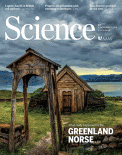You are currently viewing the abstract.
View Full TextVia AAAS ID
Accumulating impacts
Anthropogenic climate change is now in full swing, our global average temperature already having increased by 1°C from preindustrial levels. Many studies have documented individual impacts of the changing climate that are particular to species or regions, but individual impacts are accumulating and being amplified more broadly. Scheffers et al. review the set of impacts that have been observed across genes, species, and ecosystems to reveal a world already undergoing substantial change. Understanding the causes, consequences, and potential mitigation of these changes will be essential as we move forward into a warming world.
Science, this issue p. 10.1126/science.aaf7671
Structured Abstract
BACKGROUND
Climate change impacts have now been documented across every ecosystem on Earth, despite an average warming of only ~1°C so far. Here, we describe the full range and scale of climate change effects on global biodiversity that have been observed in natural systems. To do this, we identify a set of core ecological processes (32 in terrestrial and 31 each in marine and freshwater ecosystems) that underpin ecosystem functioning and support services to people. Of the 94 processes considered, 82% show evidence of impact from climate change in the peer-reviewed literature. Examples of observed impacts from meta-analyses and case studies go beyond well-established shifts in species ranges and changes to phenology and population dynamics to include disruptions that scale from the gene to the ecosystem.
ADVANCES
Species are undergoing evolutionary adaptation to temperature extremes, and climate change has substantial impacts on species physiology that include changes in tolerances to high temperatures, shifts in sex ratios in species with temperature-dependent sex determination, and increased metabolic costs of living in a warmer world. These physiological adjustments have observable impacts on morphology, with many species in both aquatic and terrestrial systems shrinking in body size because large surface-to-volume ratios are generally favored under warmer conditions. Other morphological changes include reductions in melanism to improve thermoregulation, and altered wing and bill length in birds.
Broader-scale responses to climate change include changes in the phenology, abundance, and distribution of species. Temperate plants are budding and flowering earlier in spring and later in autumn. Comparable adjustments have been observed in marine and freshwater fish spawning events and in the timing of seasonal migrations of animals worldwide. Changes in the abundance and age structure of populations have also been observed, with widespread evidence of range expansion in warm-adapted species and range contraction in cold-adapted species. As a by-product of species redistributions, novel community interactions have emerged. Tropical and boreal species are increasingly incorporated into temperate and polar communities, respectively, and when possible, lowland species are increasingly assimilating into mountain communities. Multiplicative impacts from gene to community levels scale up to produce ecological regime shifts, in which one ecosystem state shifts to an alternative state.
OUTLOOK
The many observed impacts of climate change at different levels of biological organization point toward an increasingly unpredictable future for humans. Reduced genetic diversity in crops, inconsistent crop yields, decreased productivity in fisheries from reduced body size, and decreased fruit yields from fewer winter chill events threaten food security. Changes in the distribution of disease vectors alongside the emergence of novel pathogens and pests are a direct threat to human health as well as to crops, timber, and livestock resources. Humanity depends on intact, functioning ecosystems for a range of goods and services. Enhanced understanding of the observed impacts of climate change on core ecological processes is an essential first step to adapting to them and mitigating their influence on biodiversity and ecosystem service provision.
Impacts can be measured on multiple processes at different levels of biological organization within ecosystems. In total, 82% of 94 ecological processes show evidence of being affected by climate change. Within levels of organization, the percentage of processes impacted varies from 60% for genetics to 100% for species distribution.
Abstract
Most ecological processes now show responses to anthropogenic climate change. In terrestrial, freshwater, and marine ecosystems, species are changing genetically, physiologically, morphologically, and phenologically and are shifting their distributions, which affects food webs and results in new interactions. Disruptions scale from the gene to the ecosystem and have documented consequences for people, including unpredictable fisheries and crop yields, loss of genetic diversity in wild crop varieties, and increasing impacts of pests and diseases. In addition to the more easily observed changes, such as shifts in flowering phenology, we argue that many hidden dynamics, such as genetic changes, are also taking place. Understanding shifts in ecological processes can guide human adaptation strategies. In addition to reducing greenhouse gases, climate action and policy must therefore focus equally on strategies that safeguard biodiversity and ecosystems.














